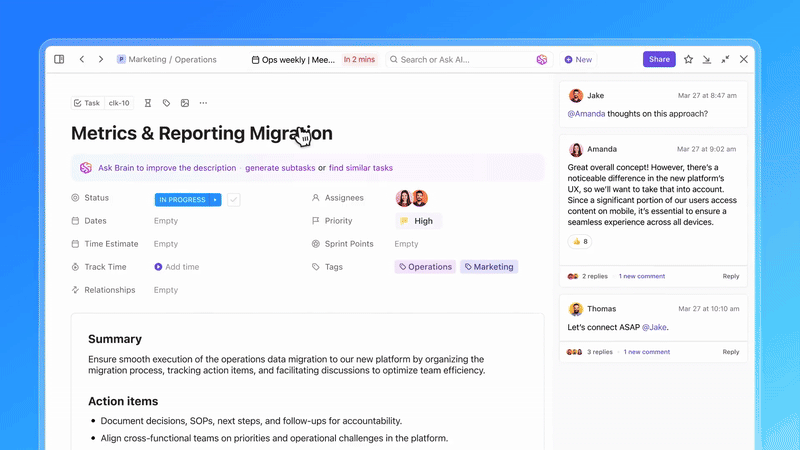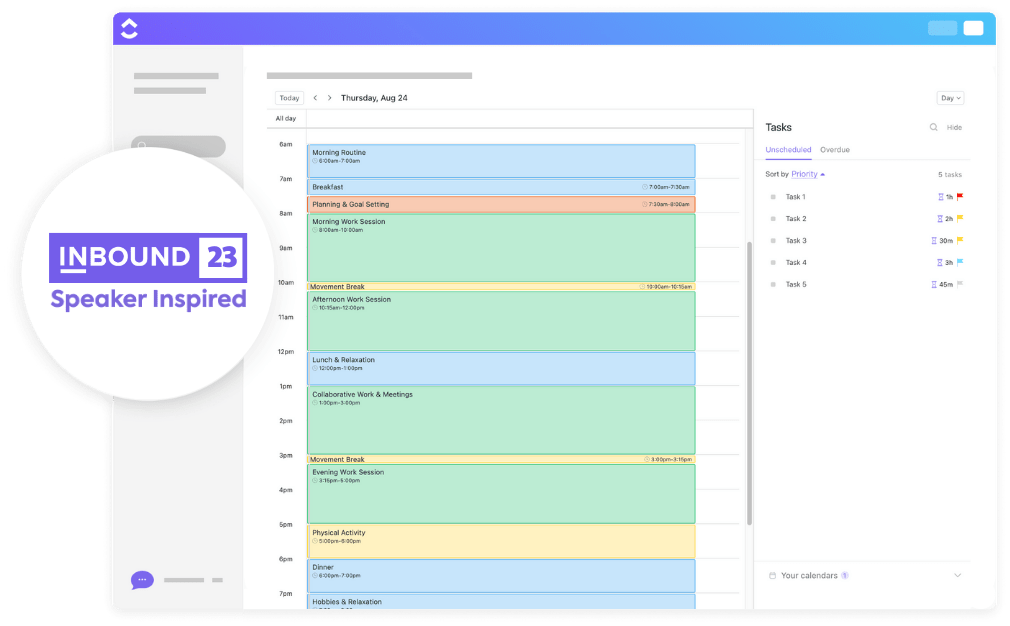効果的な時間管理ツールこそが、あなたの先延ばし癖と最高の生産性を発揮する自分との間にある唯一の壁であることを、あなたはご存知でしょう。
しかし、どのデイリープランナーアプリやスマートカレンダーが、ストレスを増やすのではなく、あなたの生活を楽にしてくれるのでしょうか?
TimeHeroとMotionという2つの名前が頻繁に話題に上ります。どちらもよりスマートな業務日、集中力の向上、期限遅延の減少を約束します。しかし、その実現方法は大きく異なります。
どちらがあなたのワークフロー(そして思考の仕方)に合っているか迷っているなら、ここが最適な場所です。機能ごとに比較してみましょう。もしどちらにも物足りなさを感じるなら、確かな代替案としてClickUpをご紹介します!
TimeHeroとMotionの比較一覧
TimeHeroとMotionの簡易比較テーブルと、おまけとしてClickUpの先行情報をご紹介します!
| 機能 | TimeHero | Motion | ⭐️ ボーナス:ClickUp |
| スケジューリングインテリジェンス | 予測可能なプランニング。構造化されたワークフローに最適です。 | /AIを活用したリアルタイムタスク再スケジュール機能により、優先度の変動や締切変更に対応します。 | カスタマイズ可能なAIカレンダー、タイムラインビュー、ガントチャートに加え、リアルタイムの変更に応じてスケジュールを動的に調整する自動化機能を備えています。 |
| プロジェクト管理 | テンプレート、タスク依存関係、詳細な追跡による堅牢なプロジェクトプラン。 | プロジェクト管理機能はカレンダー機能に次ぐ二次的なものです。 | カスタムワークフロー、タスク依存関係、コラボレーション機能をすべて1つのプラットフォームに統合した包括的なプロジェクト管理ソリューション。 |
| チームコラボレーション | 長期プロジェクトプラン、テンプレート、リソース管理に重点を置くチームに最適です。 | リアルタイムでのスケジュール調整が必要な、ペースの速いチームに最適です。 | ClickUpはリアルタイムコラボレーション、タスク割り当て、ドキュメント共有、その他のオンラインミーティングツールとの連携に優れており、あらゆる面でチームワークをシームレスに実現します。 |
| タスク自動化 | 繰り返しテンプレート、タスク依存関係、ワークロードバランス調整による高度な自動化機能。 | 定期的なタスクの基本的な自動化。 | 手作業を減らす強力な自動化機能。ルールベースのワークフローから、ClickUpのオートパイロットエージェントによる自律的なアクション実行まで。 |
| ユーザー体験とインターフェース | 機能性を重視した、より複雑なインターフェースで、デザイン性は控えめ。 | 洗練されたカレンダー中心のインターフェースがリアルタイムで適応します。 | 高度にカスタマイズ可能なユーザーフレンドリーなインターフェースと複数のビュー(リスト、ボード、ガントチャート、カレンダー)を備え、ユーザーが理想的なセットアップを柔軟に選択できます。 |
| 集中力と生産性向上ツール | リアルタイムの生産性向上リマインダー機能は搭載されていませんが、プランに重点を置いています。 | 集中時間の保護、/AIによるタスク優先順位付け、タスク注文の提案。 | 時間追跡、目標設定、タスク優先順位付け、ワークスペースなどの機能で生産性を向上させ、チームの連携と集中を維持します。 |
ClickUpにおけるソフトウェアレビューの方法
編集チームでは透明性が高く、調査に基づいたベンダー中立のプロセスを採用しているため、当社の推奨事項が実際の製品価値に基づいていることを信頼いただけます。
ClickUpにおけるソフトウェア評価の詳細な手順をご紹介します。
TimeHeroとは?
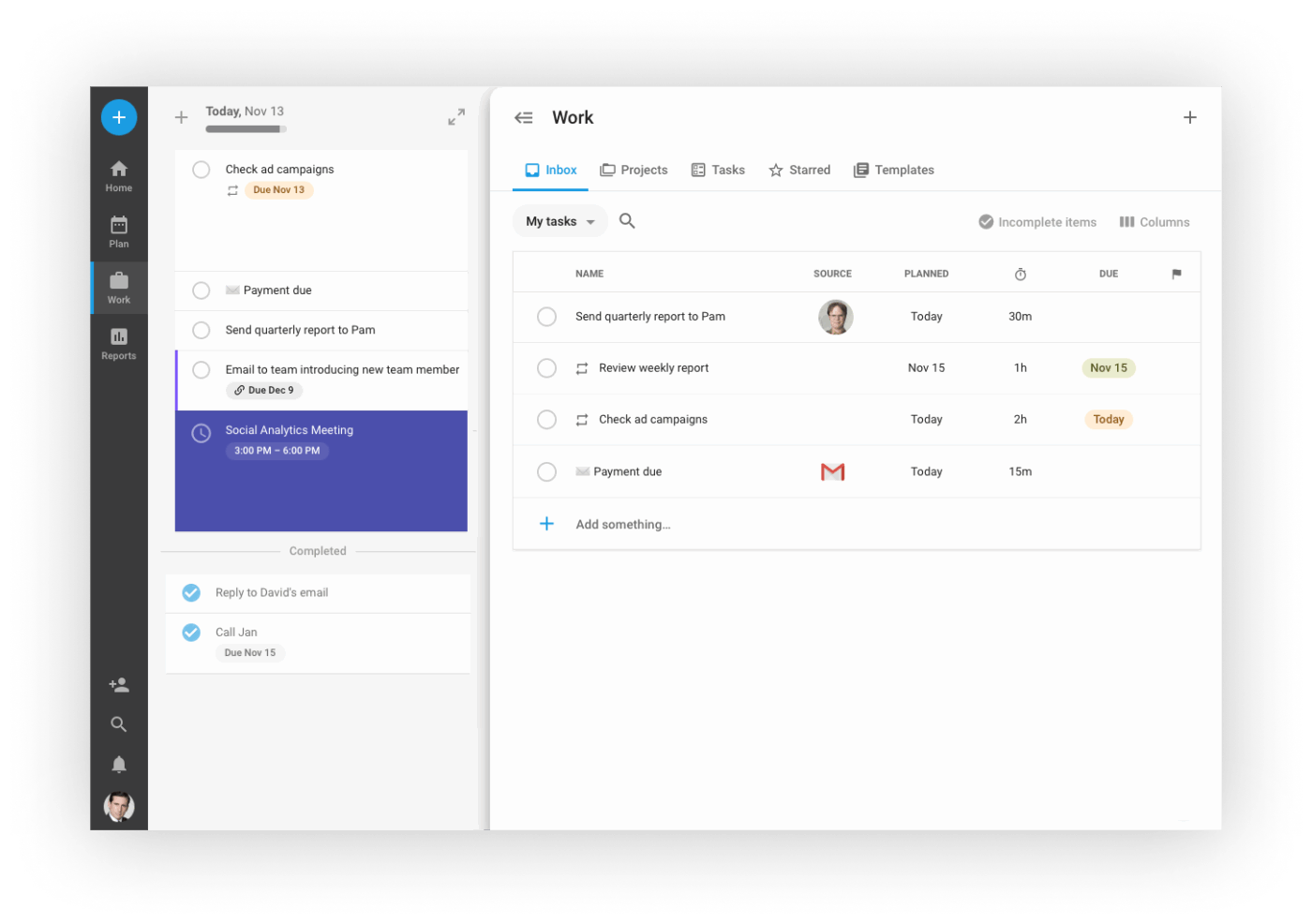
TimeHeroは、個人やチームのスケジュール管理を自動化・最適化するAI搭載のタスク・プロジェクト管理プラットフォームです。期日のみで時間を追跡する従来のタスク管理ツールとは異なり、TimeHeroは利用可能な時間、優先度、カレンダーイベントに基づいてタスクをインテリジェントにプランし、スケジュールの変更に応じて動的に適応します。
🧠 豆知識:従業員の77%が上司からのより実質的なサポートを期待している一方で、その上司たちは現実的に処理できる量より51%多い仕事を抱えています。プロフェッショナルやチームがタスク管理や時間プランの見直しを迫られているのも当然でしょう。
TimeHeroの機能
TimeHeroはプロジェクト管理カレンダーの代わりになろうとしているわけではありません——むしろその負担を軽減しようとしています。その機能はプランの自動化に徹底的に特化しているため、あなたはより多くの時間を実行に費やし、迷いながら過ごす時間を減らせます。
機能 #1: スマートなタスクスケジューリング
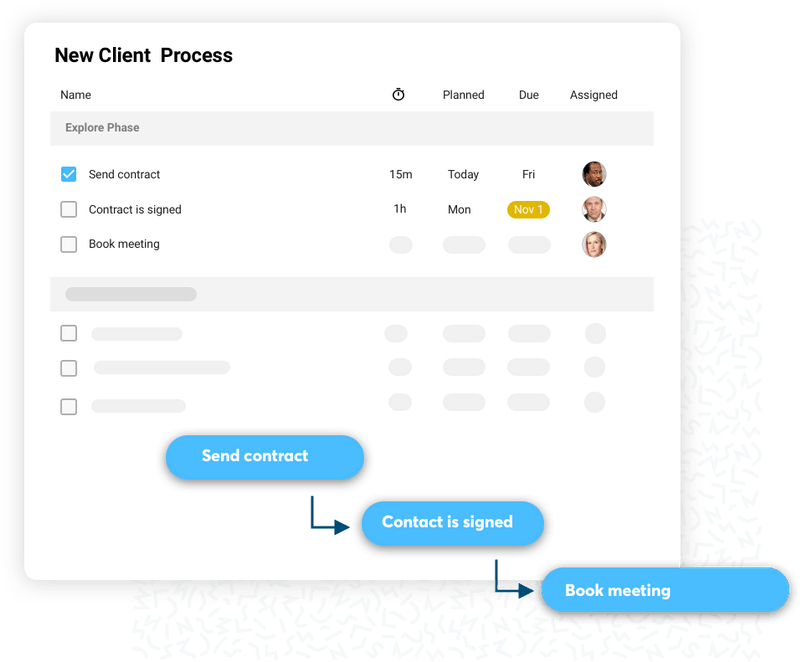
多くのタスク管理ソフトは、すべてのタスクを静的なリストに放り込み、あとは運任せです。TimeHeroはさらにステップ進んでいます——毎日どれだけの時間があるか、どのミーティングが予定されているか、各タスクの期限はいつかといった情報を分析し、自動的に現実的なスケジュールを作成します。
さらに便利な点:タスクを忘れても(生活ってそういうもの!)、TimeHeroは手動で全てを再調整する必要なく、即座にプランを再計算します。
機能 #2: ダイナミックなプロジェクトテンプレート
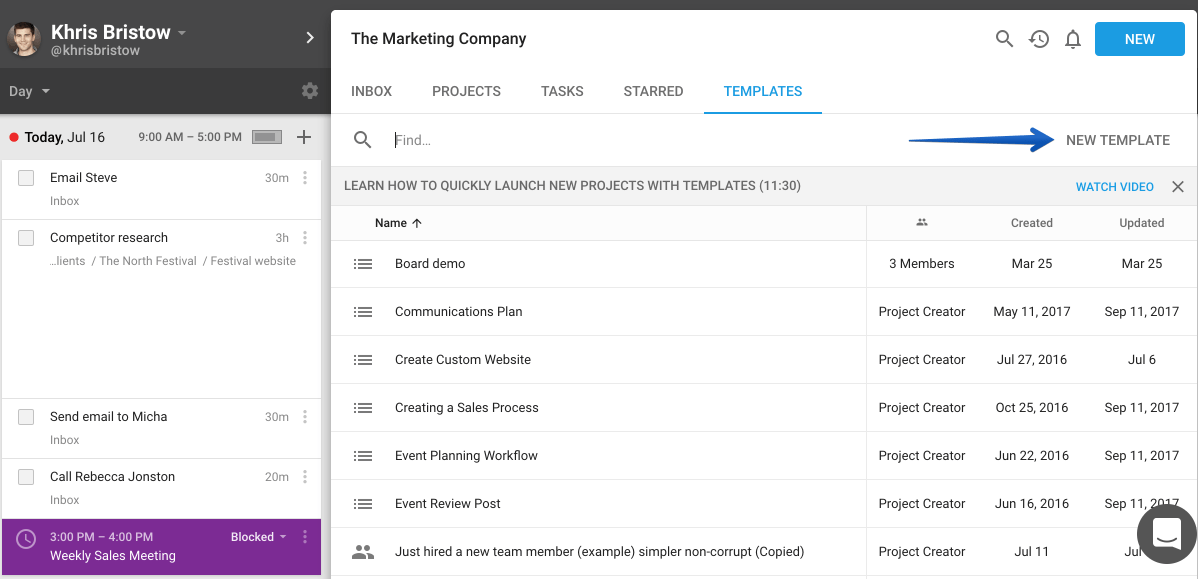
クライアントプロジェクトの立ち上げ、新入社員のオンボーディング、マーケティングキャンペーンの実施が必要ですか?TimeHeroでは、開始時期に基づいて(固定のカレンダー日付ではなく)自動的に期限とタスクを割り当てる、詳細なテンプレート化されたワークフローを作成できます。
さらに、TimeHeroのスケジュールテンプレートは柔軟性が高く、開始日や期日が頻繁に変わる現実のプロジェクトにも対応可能です。
機能 #3: 組み込みの時間追跡とレポート作成
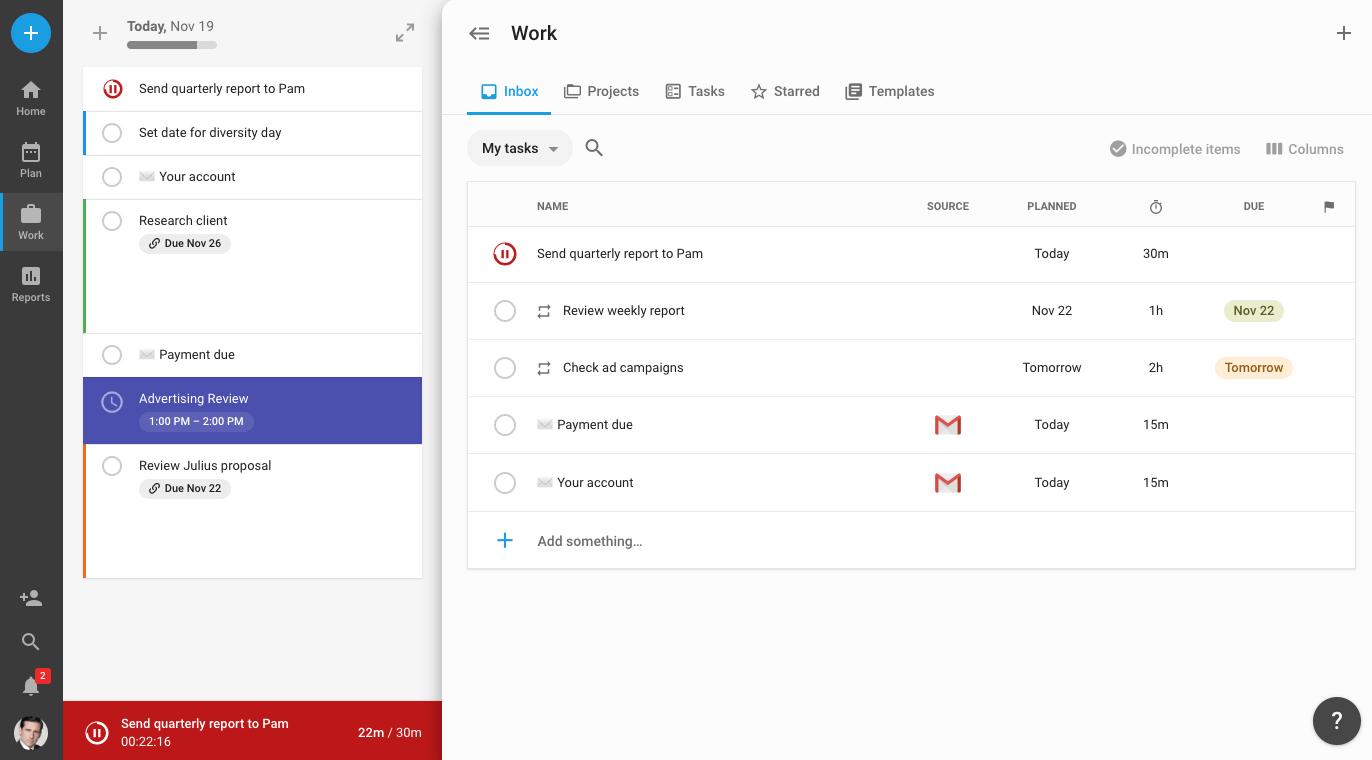
忙しい一日の終わりに、自分の時間がどこへ消えたのか疑問に思ったことはありませんか?TimeHeroは、タスクごとの作業時間を簡単に記録し、そのデータを洞察に満ちたレポートに変換することで、そのギャップを埋めるお手伝いをします。
これは単なるクライアントへの請求に役立つだけではありません。プロジェクトにどれだけの時間がかかるかを把握し、日々のプランや週単位のスケジュールをより効果的に立てるためには不可欠です。
機能 #4: 共同タスク管理

チームメンバーへのタスク割り当て、コンテキストのためのコメント残し、作業負荷の調整——これらすべてを単一プラットフォーム内で実現。TimeHeroはチームのキャパシティを視覚的に表示するため、優秀な人材に過負荷をかけるというよくある落とし穴を簡単に回避できます。
TimeHeroの価格
- 基本プラン: 月額5ドル/ユーザー
- プロフェッショナルプラン: ユーザーあたり月額12ドル
- プレミアムプラン: ユーザーあたり月額27ドル
📮ClickUpインサイト:アンケート回答者の18%が、カレンダー・タスク・リマインダーを通じて生活を整理するためにAIを活用したいと考えています。さらに15%が、日常業務や事務仕事をAIに処理させたいと回答しています。
これを行うには、AIが以下のことを可能にする必要があります:ワークフロー内の各タスクの優先度レベルを理解すること、タスク作成や調整に必要なステップを実行すること、そして自動化されたワークフローを設定すること。
多くのツールはこれらのステップのうち1~2つしか対応していません。しかしClickUpなら、最大5つ以上のアプリをプラットフォーム上で統合可能!優先度に基づいてタスクやミーティングをカレンダーの空き枠に自動割り当てするAI搭載スケジューリングを体験してください。ClickUp Brainでカスタム自動化ルールを設定し、ルーチン業務を処理することも可能です。煩雑な作業にさよならを!
Motionとは?
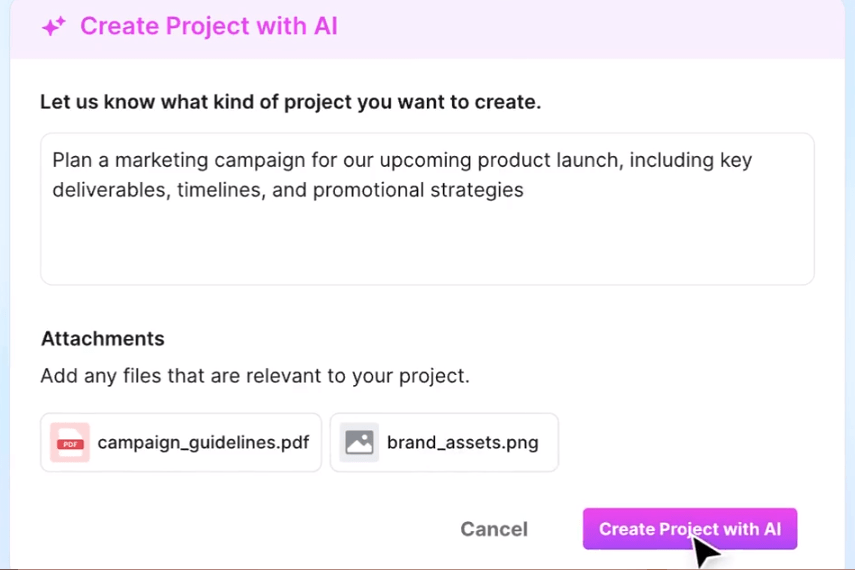
手動でのプラン立案に伴うストレスを解消するために設計されたMotionは、/AIを活用した生産性向上ツールです。タスク、ミーティング、優先度を自動的にカレンダーにスケジュールします。
締め切りの変更、ミーティングの競合、タスクの緊急度に応じて、カレンダーをリアルタイムで動的に調整します。カレンダー、やることリスト、プロジェクト管理機能を1つのプラットフォームに統合したMotionは、立て続けのスケジュールで忙しく、日々の細かな管理に時間を割けない方に最適です。
💡 プロの秘訣:パレートの法則(80/20の法則)によれば、結果の80%は注力した努力の20%から生まれます。時間管理においては、目標達成に最も大きな影響を与えるタスクを優先することを意味します。
Motionの機能
Motionの機能は、抱え込みすぎて手動で管理する余裕がない人向けに設計されています。
機能 #1: リアルタイムAIスケジューリング
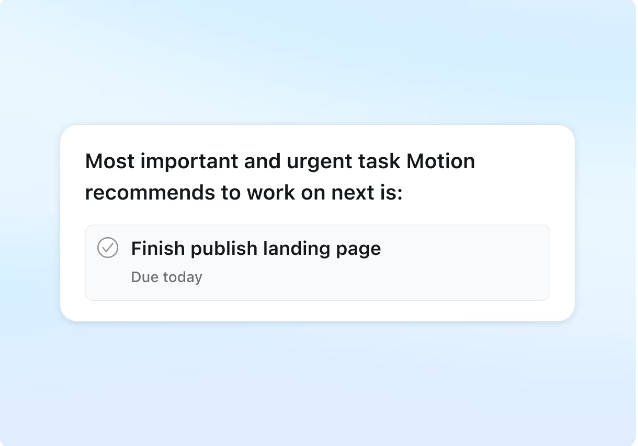
Motionがタスクをスケジュールする際、分単位で正確に仕事時間を把握します。ミーティング、集中時間、締切、優先度を分析し、動的な日次カレンダーを構築。予定が狂っても自動更新されます。
ミーティングが長引いてタスクを逃した?Motionが即座に1日のスケジュールを再最適化。優先度を犠牲にすることなく進捗を確保します。
機能 #2: 完全なプロジェクト管理
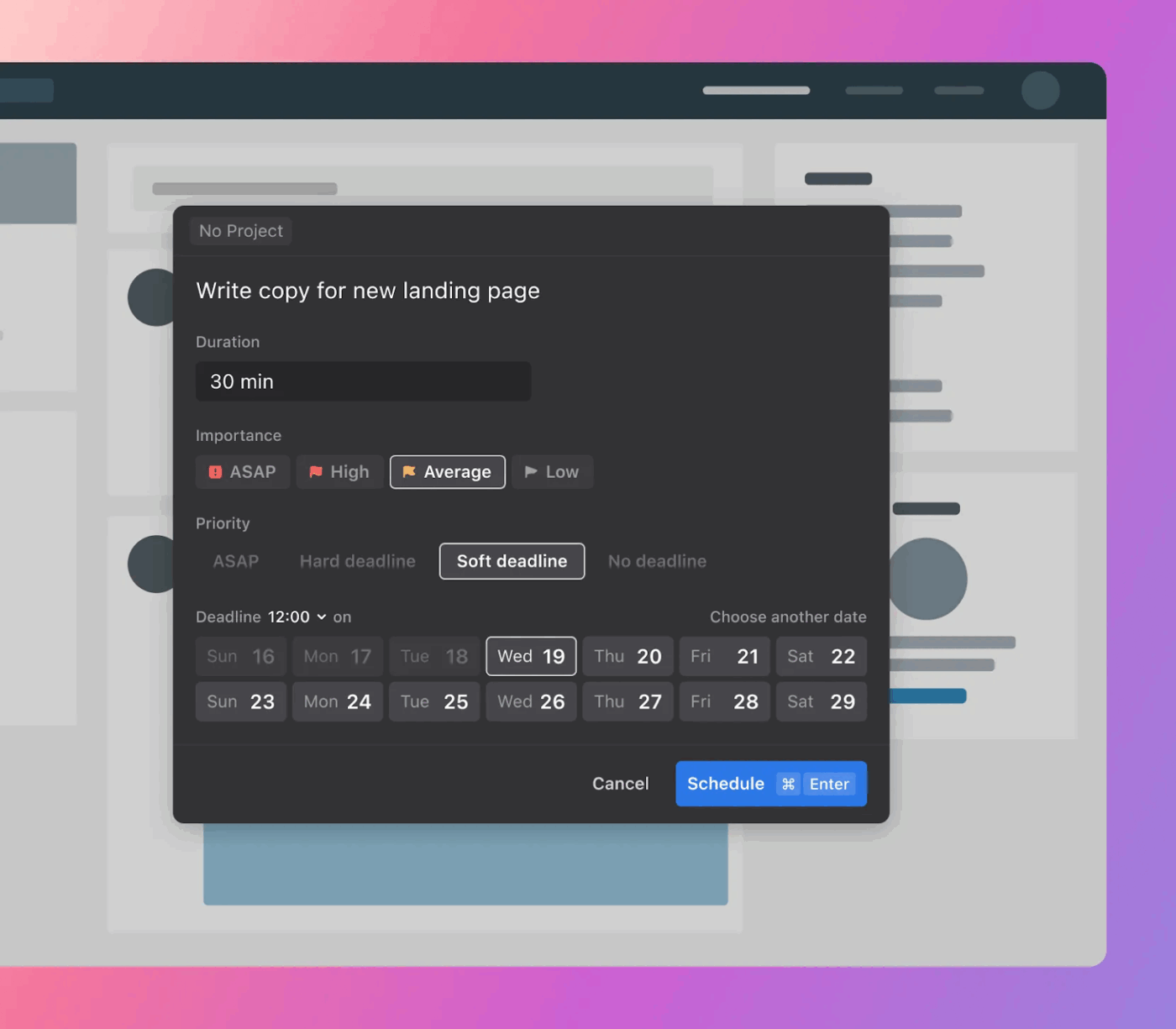
Motionは単なるタスク管理を超えた機能を提供します。完了するプロジェクトを構築し、サブタスクに分割、依存関係を設定、チームメンバーに仕事を割り当て、複数のプロジェクトの進捗を追跡しながら、すべてをカレンダーと同期させることができます。
機能 #3: ミーティングスケジュールの自動化
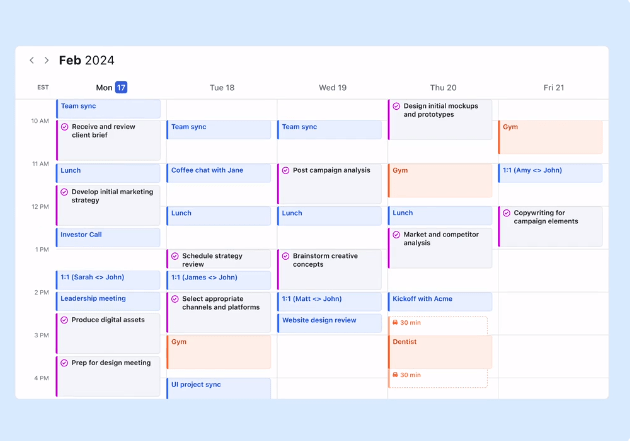
次回のミーティング日程調整で「いつ無料?」というスレッドが延々と続くのに疲れていませんか?Motionには、実際のカレンダーに基づいて最適な空き時間を自動で提案し、リンクを自動送信、必要な集中時間をブロックする機能を備えたミーティング管理スケジューラーが組み込まれています。
重要度に基づいてタスクの優先順位付けも可能です。これで、唯一の仕事時間をうっかり他の予定で埋めてしまう心配もなくなります。
機能 #4: 優先順位付きやることリスト
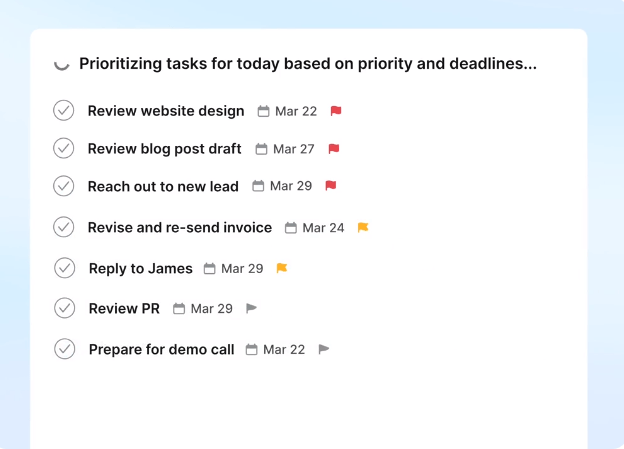
散らかったタスクリストに圧倒される代わりに、Motionは締切・重要度・空き時間に基づき、常に更新される優先順位付きやることリストを提供します。
その結果?やるべきことが明確になります。さらに、それをいつ行うかも正確に把握できます。
Motionの価格
- Pro AI: 1席あたり月額29ドル
- *Business AI: 1席あたり月額49ドル
- 企業版:カスタム見積もり
TimeHero vs. Motion:機能比較
一見するとTimeHeroとMotionは似ているように見えます。しかし、深く掘り下げると、その違いは非常に顕著で重要です。主要な機能について直接比較してみましょう:
機能 #1: スケジューリングインテリジェンス
ここがMotionの真価が発揮される機能です。AIエンジンがリアルタイムでカレンダーの優先度を継続的に再調整。新たなミーティングや期限変更、優先度変動に応じてタスクを自動再配置します。単なる空き枠埋めではなく、集中時間を守り、緊急度を最適化し、予定変更時に瞬時に対応します。
TimeHeroもインテリジェントなプラン機能を提供しますが、「設定したら後は放置」というアプローチです。構造化され予測可能な仕事には理想的ですが、絶え間ない調整を必要とする変化の激しい環境下にあるチームや個人にはあまり適していません。
🏆 勝者:Motion。プランが空中で変更される動的なスケジュールに最適で、カレンダーもあなたと同じ速さで思考する必要があります。
機能 #2: プロジェクト管理
TimeHeroは従来のプロジェクト管理に重点を置き、その分野で優れた性能を発揮します。組み込みテンプレート、調整可能な開始日と期日、タスク依存関係、リソース配分ツールが備わっており、チームが長期プロジェクトを明確に管理するのに役立ちます。個々のカレンダーだけでなく、ワークフロー全体における可視性を確保するよう設計されています。
一方、Motionはプロジェクト構造をサポートしますが、ガントチャート、テンプレート、リソースプランについては深く掘り下げていません。実行と日々のフローには最適ですが、多層的で長期的なプロジェクトの管理にはあまり適していません。
🏆 勝者:TimeHero。単なるスマートなToDoリストではなく、チームに構造、タイムライン、全体像把握が必要な場合に最適な選択肢です。
機能 #3: チームコラボレーション
最適なツールはチームの運営方法に対する依存関係にあります。Motionは優先度が頻繁に変化し、全員のスケジュールを厳密に管理する必要がある、迅速な実行重視のチームに最適です。状況が流動的でも、個人がタスクに集中し連携を維持するのを支援します。
TimeHeroは、定義されたプロジェクト範囲内で作業するチームに適しています。テンプレート、タイムライン、作業負荷のバランス調整が重要な場面で真価を発揮します。リアルタイムの実行よりもプランに重点を置いたコラボレーションを行う場合、TimeHeroの方が自然な使い心地となるでしょう。
🏆 勝者: 引き分けです。どちらを選ぶかは、チームが「構造」を重視するか「スピード」を重視するかによって決まります。両ツールはそれぞれ異なる強みを発揮します。
機能 #4: タスク自動化
TimeHeroは自動化を重視しています。定期的なタスクのテンプレート作成、チームメンバー間の作業負荷の自動分散、設定後は自動運転で稼働するワークフロー構築が可能です。特に、クライアントのオンボーディング、キャンペーン管理、レポート作成サイクルなど、反復的なタスクを扱うチームに効果的です。
Motionは基本的な定期的なタスクをサポートしますが、自動化ロジックや一括タスクルールの中核として設計されていません。手作業削減の鍵が自動化にあるなら、TimeHeroが優位に立ちます。
🏆 勝者: TimeHero。チームが反復可能なプロセスで運営され、継続的な監視なしに業務を円滑に進めるための自動化が必要な場合、より優れた選択肢です。
機能 #5: ユーザー体験とインターフェース
Motionはカレンダーを中心に据えた洗練された直感的な操作性を提供します。モダンでレスポンシブなデザインにより、個人でもチームでも迅速に導入できます。リアルタイムスケジューリングUIは、カレンダーを生活の中心としている方々に特に有用です。
TimeHeroは強力ですが、より実用的な印象を与えることがあります。そのインターフェースは機能していますが、やや複雑で視覚的に魅力に欠ける面があり、特に従来のプロジェクト管理ツールに慣れていないユーザーにとってはそう感じられるでしょう。
🏆 勝者:Motion。チームの定着率にユーザー体験が重要なら、Motionの洗練されたデザインとカレンダー中心のレイアウトが日々の継続利用を格段に容易にします。
機能 #6: 集中力と生産性向上ツール
Motionは単なるスケジュール管理ツールだと思っていませんか? それは間違いです。仕事を支援するよう設計されています。集中時間を保護し、予定が過密になった際に通知し、AIを活用して緊急度と空き状況に基づいた最も効率的なタスク注文を提案します。先延ばしやタスク過多に真正面から立ち向かうために構築されています。
TimeHeroはプランに優れる一方、実行モードを維持するリアルタイムの促し機能に欠けます。生産性コーチのように機能するツールを求めるなら、Motionが最適です。
🏆 勝者:Motion。時間を整理し、積極的に進捗管理をサポートするため、やることが山積みで終わらないと感じる時にも大きな違いをもたらします。
RedditにおけるTimeHeroとMotionの比較
Redditユーザーは実使用に基づくTimeHeroとMotionの明確な違いを指摘しています。
TimeHeroはMotionの代替ツールとして、強力な自動化機能と長期プランニング能力が高く評価されています。日々の入力作業を最小限に抑えつつ複雑なプロジェクトを管理するユーザーに支持されています。
ユーザー「finngornthegreat」 がr/生産性で次のようにメモしています:
定期的なタスク機能は非常に便利でした。経理処理や入札ポータル確認を「月内任意のタイミングで月1回」と設定すると、重要な締切の合間に自動的に割り振られ、効率的でした。この機能で毎日電子メール処理の時間をブロックできたため、「実際の」仕事をやることのできる時間をより現実的に把握できるようになりました。
定期的なタスク機能は非常に便利でした。経理処理や入札ポータル確認を「月内任意のタイミングで月1回」と設定すると、重要な締切の合間に自動的に割り振られ、効率的でした。この機能で毎日電子メール処理の時間をブロックできたため、「実際の」仕事に必要な時間をより現実的に把握できるようになりました。
ただし、他のユーザーからは操作性の悪さや習得の難しさがメンションされています。例として、 dho689 は Sorted3 との比較の中でこう述べています:
TimeHeroのAIは、空き時間枠にタスクを自動的にスケジュールする点で優れていますが、UI/UXは動作が遅くバグが多いです。リアルタイムでスケジュールを調整するため(ボタン操作不要)、動作が遅いのは理解できますが、アプリのアップデートがほとんど行われていません。
TimeHeroのAIは、空き時間枠にタスクを自動的にスケジュールする点で優れていますが、UI/UXは動作が遅くバグが多いです。リアルタイムでスケジュールを調整するため(ボタン操作不要)、動作が遅いのは理解できますが、アプリのアップデートがほとんど行われていません。
一方、Motionは/AIを活用した日々のプラン立案機能が高く評価されています。ユーザーは意思決定の疲労を軽減する点に満足しています。
RedditユーザーFrancescoD_ales がr/ProductivityAppsで次のように述べています:
優先順位付けの負担を減らしたい方に適していますが、タスクごとに大量の情報を追加し続ける必要があります。カレンダーと/AIを重視する方なら、これは良い選択肢です。
優先順位付けの負担を減らしたい方に適していますが、タスクごとに大量の情報を追加し続ける必要があります。カレンダーと/AIを重視する方なら、これは良い選択肢です。
デメリットは?高額な価格設定と大規模チームでの運用難。Redditユーザーruckk2はこう述べています:
Motionの存在は以前から知っていましたが、かなり高額だったので試したことはありませんでした…、
Motionの存在は以前から知っていましたが、かなり高額だったので試したことはありませんでした…、
総合的に見て、スマートな日々のプランが必要な場合はMotionが最適です。構造化された長期プロジェクトの実行においては、TimeHeroが優位性を持ちます。
ClickUpのミーティング―TimeHeroとMotionに代わる最良の選択肢
TimeHeroとMotionの両方の機能に魅力を感じつつも、さらに多くの機能を備えたプラットフォームをお探しなら、仕事のすべてをカバーするアプリ「ClickUp」を検討する時が来ました。
コンパウンドのデジタルトランスフォーメーションコンサルタント、アリステア・ウィルソン氏も同意見です。
複数の選択肢を精査した結果、総合的に見てClickUpがパワーと柔軟性の最適な組み合わせを提供すると判断しました。また、外部アプリやサービスを追加せずに外部契約者のタイムログを追跡・測定する問題も解決する必要がありました。ClickUpのネイティブ時間追跡機能は、モバイル、タブレット、デスクトップ間でシームレスに連携します。
複数の選択肢を精査した結果、総合的に見てClickUpがパワーと柔軟性の最適な組み合わせを提供すると判断しました。また、外部アプリやサービスを追加せずに外部契約者のタイムログを追跡・測定する問題も解決する必要がありました。ClickUpのネイティブ時間追跡機能は、モバイル、タブレット、デスクトップ間でシームレスに連携します。
生産性の追跡・向上と時間管理をより効果的に行う上で、ClickUpがより賢明な選択である理由は以下の通りです:
ClickUpのワンアップ #1:AIカレンダー + ClickUp Brain(AIアシスタント)
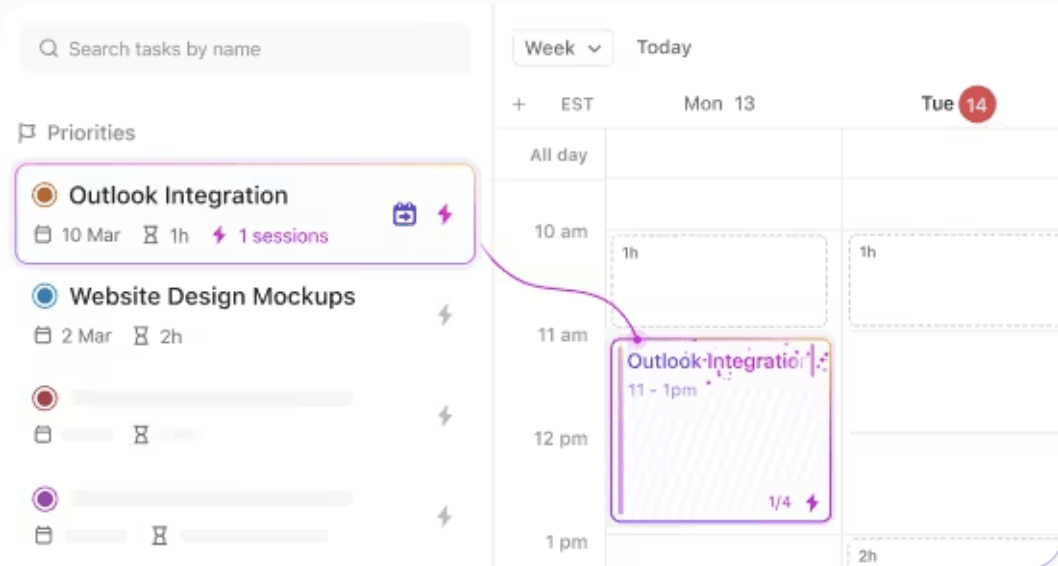
ClickUp AIカレンダーは、単に1日を整然とした時間ブロックに分割するだけではありません。あなたにとって最適なバージョンを構築します。Googleカレンダーと同期し、バックログからイベントを取得、集中時間を自動ブロック、自然言語コマンドでミーティングをスケジュールします。カレンダーと仕事を接続するスマートな指令センターです。
カレンダー、ClickUp Docs、タスク間で全てが連携されるため、見落とし(付箋に埋もれることも)が一切発生しません。
計画とスケジューリングをさらに簡単にするために、ClickUp Brainが活用できます。これはタスク、プロジェクト、チームメンバーの状況を把握する世界最高峰のワークAIです。プロジェクトのタイムラインを自動生成し、複雑なプロジェクトに取り組むためのタスク説明やサブタスクを草案化し、作業が停滞した際に次のステップを提案することで、タスク管理を簡素化します。
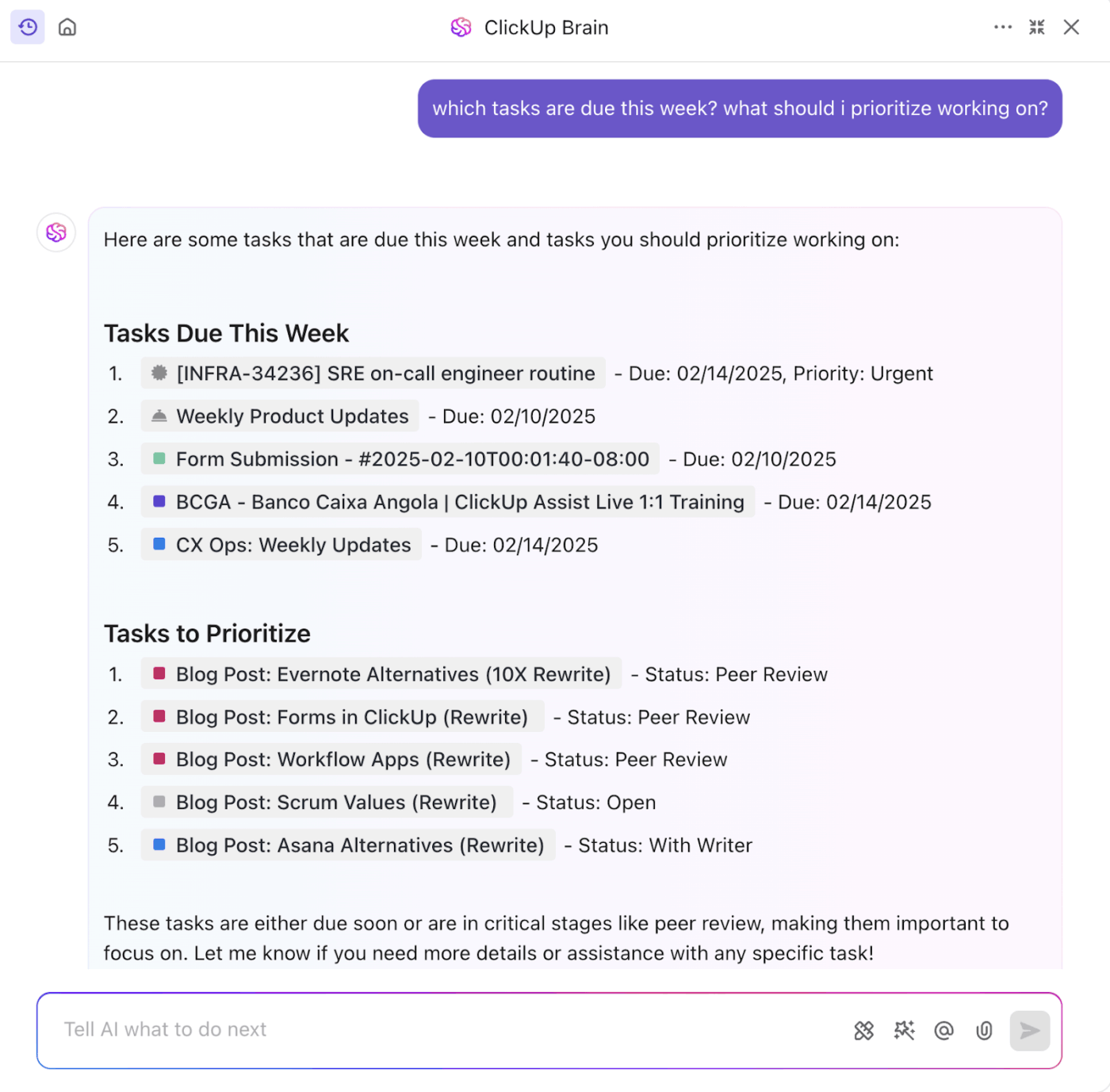
AI優先順位付けで競合するコミットメントを自動優先順位付けし、AI割り当てで各メンバーの専門領域と知見に基づき適切なチームメンバーにタスクを割り当てます。ビデオガイドはこちら:
MotionのAIが単に1日のスケジュールを組むだけなのに対し、ClickUp Brainは実際に大規模なプランと実行を支援します。
💡 プロの秘訣:ClickUp Brain MAXはAI搭載のデスクトップアシスタント。あなたの声を最も有用な生産性向上ツールに変えます。
ClickUpのBrainMAX搭載「Talk to Text」機能を使えば、タスク・ミーティング・リマインダー・メモをハンズフリーで音声入力できます。リマインダー設定、ドキュメント作成、タスク割り当て、さらにはミーティングスケジュールまで、文字を打つことなく音声でショートカット操作が可能です。
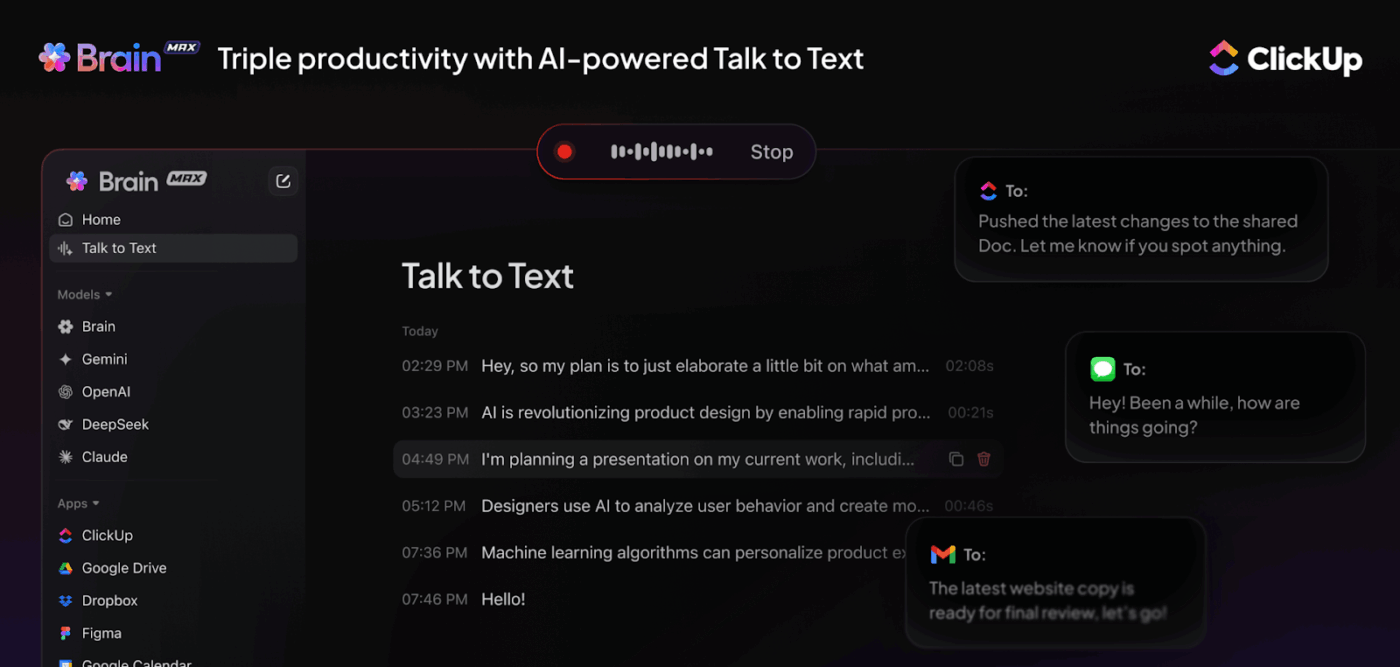
🧠 豆知識: ジェネレーティブAIはデスクワーク従事者の生産性を向上させ、週平均4.11時間の時間節約を実現しています。
ClickUpのワンアップ #2:時間追跡+柔軟なタスクビュー
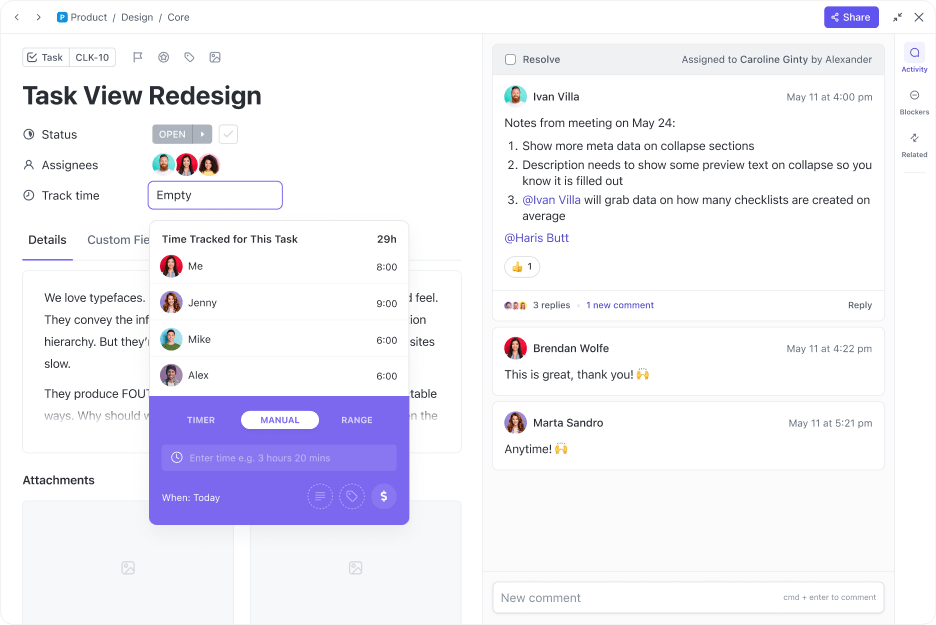
TimeHeroがプロジェクト自動化を提供し、Motionがカレンダー管理に重点を置く一方、ClickUpではあらゆる仕事を最適なビューで可視化・追跡・管理できます。
ClickUpプロジェクト時間追跡機能を使えば、時間を追跡するために拡張機能やサードパーティ製ツールは不要です。手動で記録するか、仕事中にタイマーを開始・停止し、請求可能時間をマークし、プロジェクト別、クライアント別、チームメンバー別の詳細な時間レポートをビューできます。
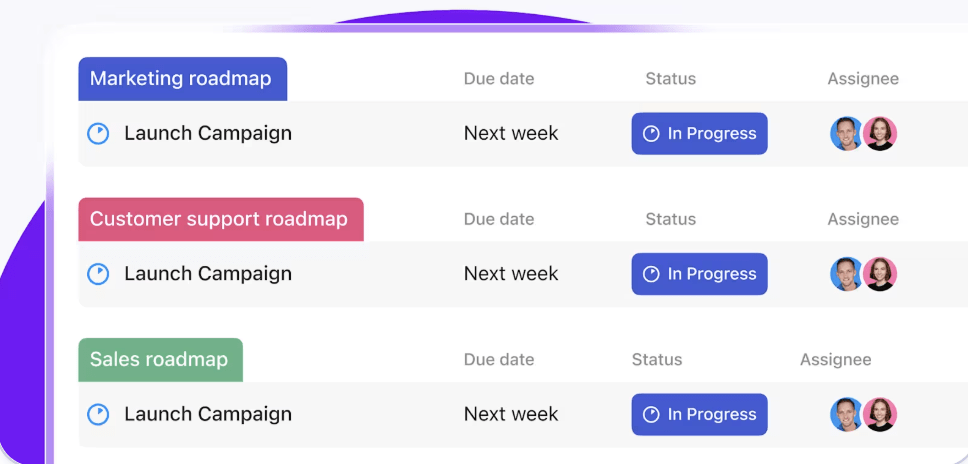
ClickUpタスクごとに時間が記録されるため、見積もりと実績を比較し、期待値を調整できます。
最大の利点は?リスト、ボード、カレンダー、タイムライン、ガントチャート、ワークロードなど、15種類以上のカスタマイズ可能なClickUpビューから選択でき、複数の視点からタスクを管理・追跡できることです。
実際、ShopMonkeyのような主要企業では、効率的なタスク管理と簡素化されたコラボレーションツールを備えたClickUpを活用し、マーケティングリーダーシップレビューと承認を50%短縮して完了するようになっています。
プロジェクトのマイルストーン追跡、チームの作業負荷管理、あるいは日々のタスク管理が必要な場合でも、ClickUpはあらゆる面で生産性を最適化する柔軟性を提供します。
💡 プロの秘訣:ClickUpのタイムシートを活用して時間の浪費箇所を見つけ、1週間を取り戻しましょう。タスクやサブタスクで追跡した時間を自動的に集約し、一元化された週間ビューに表示します。
その後、毎週金曜日に5分間かけてタイムシートを確認しましょう:
- 時間を浪費する反復的で価値の低いタスクを特定する
- 見積もりを常に超過する仕事を特定する
- タグ、担当者、タスク種別でフィルターをかけて、あなたの時間が本当にどこに費やされているのかを確認しましょう
これにより、類似タスクのバッチ処理、効果的な業務委任、高影響度仕事のための集中時間のブロックが可能になります。
ClickUpのワンアップ #3:タイムブロックテンプレート
Motionの自動スケジュール機能の構造は欲しいが、もっと柔軟性が欲しいですか?ClickUpのタイムブロッキングテンプレートなら、1日を完全にコントロールできます。タスクブロックを視覚的にドラッグ&ドロップで並べ替え、実際のタスクとリンクさせ、各ブロックの前後で発生する処理を自動化することも可能です。
予定を急に変更する必要が?このテンプレートならそれも可能です。構造化と柔軟性の両方が必要な方に最適です。
📮ClickUpインサイト:Mondayの憂鬱?実はMondayは週間生産性の弱点(意図しない駄洒落)として際立っており、35%の労働者が最も生産性の低い日と認識しています。この落ち込みは、月曜朝の更新情報や週間優先度を探すのに費やす時間とエネルギーに起因すると考えられます。
ClickUpのようなすべて仕事アプリがここで役立ちます。例えば、ClickUpに組み込まれたAIアシスタント「ClickUp Brain」は、重要な更新情報や優先度を数秒でまとめて把握できます。さらに、統合アプリを含む仕事に必要なあらゆる情報は、ClickUpの「Connected Search」で検索可能です。ClickUpのナレッジマネジメントを活用すれば、組織全体の共有リファレンス構築も簡単です!💁
ClickUpのワンアップ #4:真の柔軟性を備えた定期的なタスク
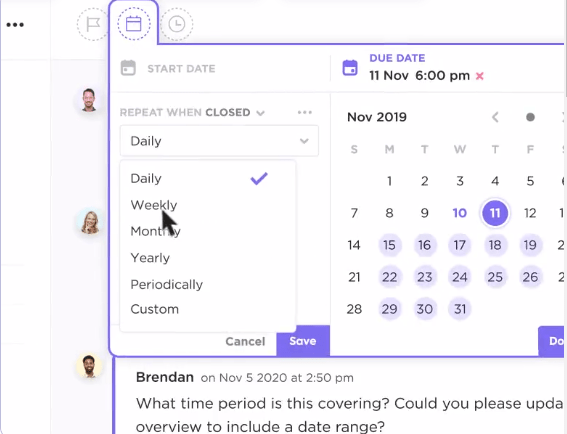
TimeHeroの自動化機能やMotionのカレンダー中心のアプローチと比較して、ClickUpのシステムは推測の余地なく反復可能な複雑なワークフロー向けに設計されています。
ClickUpの定期的なタスクシステムは高度にカスタマイズ可能です。タスクを毎日、毎週、毎月、完了した後、またはカスタムスケジュールで繰り返し発生させることができます。コメントやサブタスクなどのデータを引き継ぐことも、各繰り返しをゼロから開始することも可能です。
さらに、週末や休日をスキップする条件を設定したり、新規タスクを同じ場所か指定スペースに表示するかを制御できます。
📖 こちらもご覧ください:生産性を高めるためのタイムブロック活用方法
ClickUpのワンアップ #5:高度な自動化機能
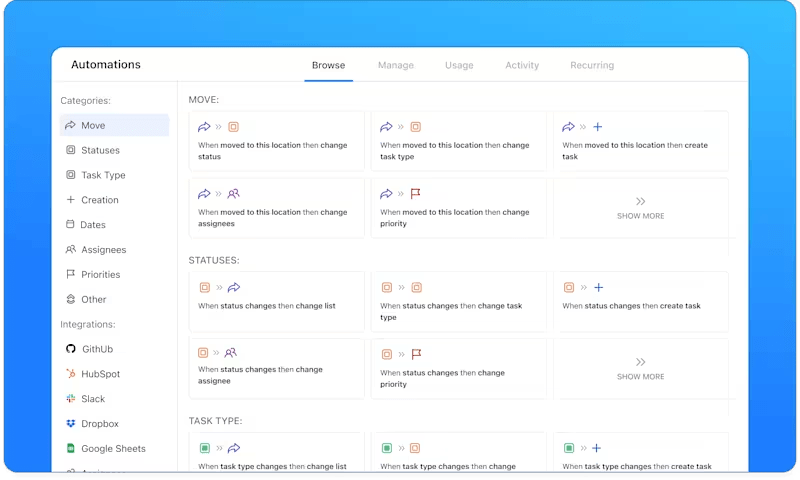
ClickUpの自動化機能は、カスタマイズ可能な「if-this-then-that」ロジックで反復作業を完全に制御します。サブタスク完了時にタスクを「進行中」へ移動させたいですか?取引が閉じた時にSlack通知を送信したいですか?数秒で設定可能です。
自動化機能では、期日やステータス変更、フォーム提出などのトリガーに基づき、チームメンバーの割り当て、優先度の更新、タグの追加、リマインダー送信なども実行可能です。
ClickUpのワンアップ #6:作業負荷管理とチームの可視性
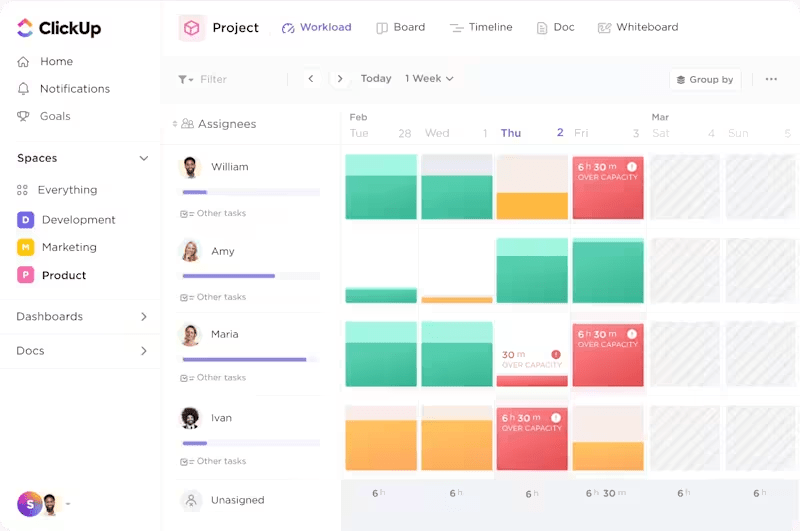
Motionはあなたの個人スケジュールに焦点を当てます。TimeHeroはプロジェクトのフローを管理します。ClickUpはチームの誰が過負荷で誰にキャパシティがあるかを含むすべてを表示します。
ClickUpのワークロードビューでは、見積もり時間、努力ポイント、またはタスク数に基づくタスク配布をリアルタイムで確認できます。その場で作業を再割り当てし、プロジェクト範囲を調整して作業負荷をバランスさせることが可能です。
👀 ご存知ですか? 従業員の半数未満しか最適なパフォーマンスを発揮できておらず、多くの人が目標不明確、リソース不足、非効率な管理といった障壁に直面しています。これは、チームが潜在能力を最大限に発揮できるよう支援する、より優れたツール、サポート、戦略の必要性を浮き彫りにしています。
最終結論:ClickUp—あらゆるニーズに対応する最高の時間管理・スケジュール管理ツール
では、最終的な結論は?
TimeHeroは、落ち着いて計画的にプロジェクトを実行したい場合に最適です。一方、MotionはAI搭載のやることリストアプリで5分ごとにスケジュールを再構築したい場合に優れた選択肢です。
ClickUpは、スケジュール管理、プロジェクト管理、AI、自動化、チームマネージャーを妥協なくすべて求める方々のために設計されています。両方の長所を兼ね備えたツールです。AIカレンダーとスマートなプロジェクトマネージャーが、完了する生産性エコシステムへとつながります。
タスクやプロジェクトと連動するドキュメント、ブレインストーミングやマインドマップ作成用のホワイトボード、クライアントやチームのリクエストを収集するフォーム、さらにはワークスペース内での会話用ClickUpチャットまで含まれています。
目標の設定と追跡、オンボーディングからコンテンツ計画まですべてで活用できるテンプレートの利用、Slack、Zoom、Google カレンダー、GitHub、Notionなど1,000以上のツールとの連携が可能です。
その深さは他に類を見ません。今すぐClickUpを無料登録して始めましょう。
